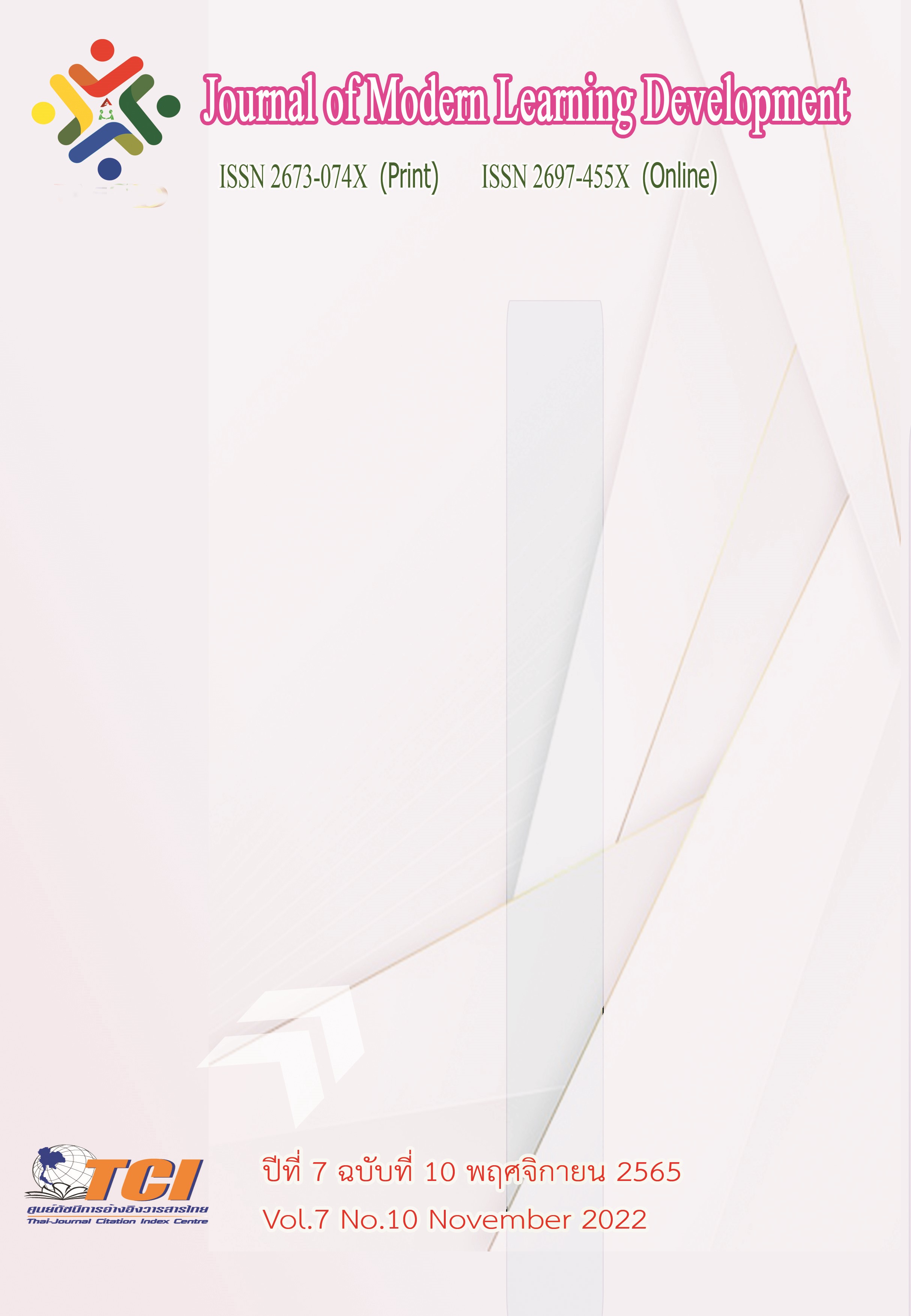The Results on Learning Cell Based on Gamification Concepts Toward Mathematical Achievement and Problem Posing Ability for Mathayomsuksa Five Students at Matthayom Watbuengthonglang School in Bangkok
Main Article Content
Abstract
The purposes of this research were as follows: (1) to compare the student's mathematical achievements before and after learning; (2) to compare the mathematical achievements of the students after learning with the 70% criterion; (3) to compare the mathematical problem posing ability of the students before and after learning; and (4) to compare the mathematical problem posing ability of students after learning with the 70% criterion. The subjects of this study were 26 Matthayomsuksa Five students in the Science-Mathematics program in the second semester of the 2021 academic year at Matthayom Wat Bueng Thonglang School in Bangkok. They were randomly selected using cluster random sampling. The experiment lasted for 18 fifty-minute periods. The findings were as follows:(1) the mathematical achievements of students in the experimental group after learning was statistically higher than before learning and the 70% criterion and at a .05 level of significance; and (2) the mathematical problem posing ability of the students in the experimental group after learning was statistically higher than before learning and the 70% criterion with a .05 level
of significance.
Article Details
References
ฉัตรพงศ์ ชูแสงนิล. (2561). เกมมิฟิเคชั่น เรียนเล่นให้เป็นเกม. ออนไลน์. สืบค้นเมื่อ 24 กันยายน 2564 แหล่งที่มา : https://www.scimath.org/article-technology/item/8669-2018-09-11-08-06-48
ชมนาด เชื้อสุวรรณทวี. (2561). การเรียนการสอนคณิตศาสตร์. กรุงเทพมหานคร: โรงพิมพ์แห่งจุฬาลงกรณ์มหาวิทยาลัย.
ทิศนา แขมมณี. (2551). รูปแบบการเรียนการสอน : ทางเลือกที่หลากหลาย. กรุงเทพมหานคร : สำนักพิมพ์แห่งจุฬาลงกรณ์มหาวิทยาลัย.
ธนาภรณ์ ลัดดาสวัสดิ์. (2564). การศึกษาผลสัมฤทธิ์ทางการเรียนวิชาคณิตศาสตร์ เรื่อง สมการเชิงเส้นตัวแปรเดียวด้วยการจัดการเรียนรู้โดยใช้แนวคิดเกมมิฟิเคชันของนักเรียนชั้นมัธยมศึกษาปีที่ 1 โรงเรียนสาธิตมหาวิทยาลัยราชภัฏสวนสุนันทา (ฝ่ายมัธยม). Journal of Roi Kaensarn Academi. 6 (7), 344 – 355.
นุชลี อุปภัย. (2555). จิตวิทยาการศึกษา. (พิมพ์ครั้งที่ 2). กรุงเทพมหานคร : สำนักพิมพ์แห่งจุฬาลงกรณ์มหาวิทยาลัย.
บุญชม ศรีสะอาด. (2541). การพัฒนาการสอน. (พิมพ์ครั้งที่ 2). กรุงเทพมหานคร : ชมรมเด็ก.
พระราชบัญญัติการศึกษาแห่งชาติ พุทธศักราช 2542. (2542). ราชกิจจานุเบกษา (เล่มที่ 116 ตอนที่ 74ก หน้า 7). ออนไลน์. สืบค้นเมื่อ 30 มีนาคม 2565. แหล่งที่มา : https://www.moe.go.th/backend/ wp-content/uploads/2020/10/1.-พระราชบัญญัติการศึกษาแห่งชาติ-พ.ศ.2542-ฉ.อัพเดท.pdf
วชิราพร ภักค์คุณพันธ์. (2561). การศึกษาผลสัมฤทธิ์ทางการเรียนและแรงจูงใจในการเรียนวิชาคณิตศาสตร์ของนักเรียนชั้นมัธยมศึกษาปีที่ 2 ที่ได้รับการจัดการเรียนรู้โดยใช้แนวคิดเกมมิฟเคชันร่วมกับการเรียนรู้แบบร่วมมือ. การประชุมวิชาการระดับชาติ ด้านนวัตกรรมเพื่อการเรียนรู้และสิ่งประดิษฐ์ ครั้งที่ 2 ประจำปี 2561, 206 – 215.
ศิริพร ลีพิมพ์. (2561). การพัฒนาการจัดการเรียนรู้โดยใช้ชุดการเรียนแบบเรียนเป็นคู่เพื่อส่งเสริมความสามารถในการแก้ปัญหา เรื่อง สมการเชิงเส้นตัวแปรเดียว. วารสารวิชาการอุตสาหกรรมศึกษา. 12 (2), 106 – 125.
ศูนย์ดำเนินงาน PISA แห่งชาติ สถาบันส่งเสริมการสอนวิทยาศาสตร์และเทคโนโลยี. (2564). ผลการประเมิน PISA 2018 การอ่าน คณิตศาสตร์ และวิทยาศาสตร์. กรุงเทพมหานคร : สถาบันส่งเสริมการสอนวิทาศาสตร์และเทคโนโลยี (สสวท.).
สถาบันทดสอบทางการศึกษาแห่งชาติ (สทศ.). (2563). สรุปผลการทดสอบทางการศึกษาระดับชาติขั้นพื้นฐาน ระดับชั้นมัธยมศึกษาปีที่ 6 ปีการศึกษา 2562. ออนไลน์. สืบค้นเมื่อ 30 มีนาคม 2565 แหล่งที่มา : http://www.newonetresult.niets.or.th/AnnouncementWeb/PDF/SummaryONETM6_2562.pdf
สำนักงานคณะกรรมการการศึกษาขั้นพื้นฐาน กระทรวงศึกษาธิการ. (2560). ตัวชี้วัดและสาระการเรียนรู้แกนกลางกลุ่มสาระการเรียนรู้คณิตศาสตร์ (ฉบับปรับปรุง พ.ศ. 2560) ตามหลักสูตรแกนกลางการศึกษาขั้นพื้นฐาน พุทธศักราช 2551. กรุงเทพมหานคร: โรงพิมพ์ชุมนุมสหกรณ์การเกษตรแห่งประเทศไทย จำกัด.
สำนักงานปลัดกระทรวงศึกษาธิการ. (2559). แผนพัฒนาการศึกษาของกระทรงศึกษาธิการ ฉบับที่ 12 (พ.ศ.2560 - 2564). ออนไลน์. สืบค้นเมื่อ 30 มีนาคม 2565 แหล่งที่มา : http://www.kknpeo.moe. go.th /2018/wp-content/uploads/2018/11/เล่มแผนพัฒนาการศึกษาของกระทรวงศึกษาธิการ-ฉบับที่-12-พ.ศ.-2560-2564-1-1.pdf
อัมพร ม้าคนอง. (2559). ทักษะและกระบวนการทางคณิตศาสตร์ : การพัฒนาเพื่อพัฒนาการ. (พิมพ์ครั้งที่ 3). กรุงเทพมหานคร : ศูนย์ตำราและเอกสารทางวิชาการ คณะครุศาสตร์ จุฬาลงกรณ์มหาวิทยาลัย.
Hammer, Jessica. (2011). Gamification in Education: What, How, Why Bother?. Academic Exchange Quarterly. 15 (2), 1 - 5.
Papp, Theresa A.. (2017). Gamification Effects on Motivation and Learning: Application to Primary and College Students. International Journal for Cross-Disciplinary Subjects in Education. 8 (3), 3193 - 3201.


